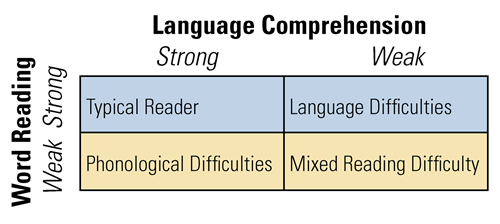Approximate time to complete: 45 minutes
Download the Course Companion document before starting this course. You can use the Companion Document to take notes on your learning, address reflection prompts and as an easy way to retrieve course resources.
Learning Objectives:
Participants in this course will be able to:
- Explain the Simple View of Reading and its significance for reading instruction
- Examine their current approaches to reading instruction to identify ways in which it aligns or does not align to the Simple View of Reading
Consider This Scenario
Connection Point
In your Course Companion Document, consider these questions:
- Can you relate to this scenario? In what ways are your challenges in literacy instruction similar or different?
Ms. Schweizer is the lead literacy coach for her district. In her role, she supports teachers at all levels to better understand and implement good reading instruction. She knows that learning to read is a complex process and has worked to support her educators to engage with as many aspects of reading as possible in their classrooms. However, the application has been uneven. Some teachers seem to understand what it takes to teach their students while others are still confused. Ms. Schweizer knows that she needs a model or approach that can get everyone on the same page, but she is not sure what this might look like.
What is the Simple View of Reading?
The Simple View of Reading is a formula based on the widely accepted view that reading includes two basic components: decoding (word-level reading) and language comprehension. Understanding the Simple View of Reading can help educators assess language and literacy strengths and weaknesses, then provide appropriate evidence-based instruction
Figure 1. The SIMPLE VIEW OF READING
The Simple View of Reading with Carolyn Turner
In this video, Ohio Literacy Lead Carolyn Turner describes the Simple View of Reading and how it can shape approaches to reading instruction. There is a place in your Course Companion to take notes.
Knowledge Check
Take the following short quiz to test your knowledge. Press the square button to expand the survey.
Resources
Read through the excerpt on Learners with Difficulties in Reading or Writing K-12 from Ohio's Plan to Raise Literacy achievement. Answer the following question in your Course Companion:
- Consider the model for types of reading difficulties (table below). How do you currently serve students who fit into each category? Is there anything from the video or article in this course that can help you to improve your approaches? If so, what?
Figure 1. Types of Reading and Writing Difficulties

Course Reflection
Answer the following questions in your Course Companion:
- What information from this course affirmed or challenged your current approach to literacy instruction?
- What is one thing from the course that you would like to learn more about?
- What is one action step you can take, based on your learning, to improve your current approach to literacy instruction? Who else from your building or district may need to be involved?
To Learn More
If you want to learn more, please see:
Feedback:
Please take a moment to fill out this feedback form. We will use your feedback to improve this and other courses.
Last Modified: 10/12/2023 10:23:20 AM